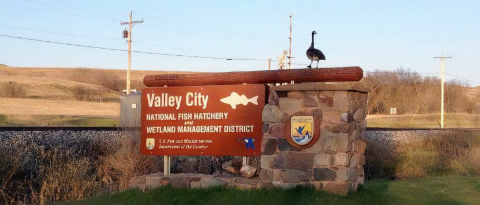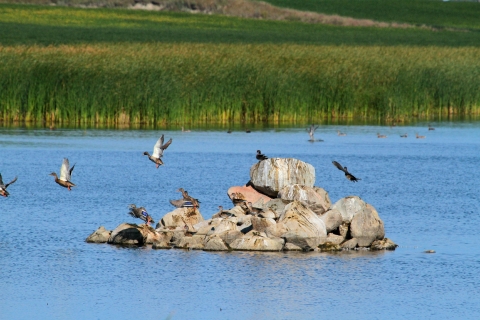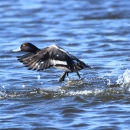About Us
Established in 1971, Valley City Wetland Management District manages both Service-owned waterfowl production areas as well as wetland and grassland easements on private lands located in Barnes, Cass, Griggs, Steele, and Traill counties.
The eastern one-third of the District is located in the Red River Valley. This area, characterized by flat, intensively farmed lands, was once the lakebed of Glacial Lake Agassiz. The remaining two-thirds of the District is part of the Prairie Pothole Region. This Region is characterized by gently rolling hills amongst numerous wetlands. The rolling hills were created by deposits of rock, soil, and mineral left behind as the glaciers receded more than10,000 years ago. The wetlands ranging in size from less than 1 acre to several hundred acres.
Land use throughout the District is primarily agriculture, with wheat, barley, corn, soybeans and sunflowers being the main crops. The meandering and wooded Sheyenne River Valley, with its numerous draws and pastures, offers a welcome contrast and visual relief from the intensively farmed land throughout the District. Besides visual relief, the valley provides habitat for a variety of non-prairie wildlife such as wood ducks, tree squirrels, beavers, and a multitude of woodland birds.
Our Mission
Each unit of the National Wildlife Refuge System is established to serve a statutory purpose that targets the conservation of native species dependent on its lands and waters. All activities on those acres are reviewed for compatibility with this statutory purpose.
The mission of the National Wildlife Refuge System is to administer a national network of lands and waters for the conservation, management and, where appropriate, restoration of the fish, wildlife and plant resources and their habitats within the United States for the benefit of present and future generations of Americans.
Other Facilities in this Complex
Valley City Wetland Management District is part of the Eastern North Dakota Complex. A National Wildlife Refuge Complex is an administrative grouping of two or more refuges, wetland management districts or other refuge conservation areas that are primarily managed from a central office location. Districts and refuges are grouped into a complex structure structure
Something temporarily or permanently constructed, built, or placed; and constructed of natural or manufactured parts including, but not limited to, a building, shed, cabin, porch, bridge, walkway, stair steps, sign, landing, platform, dock, rack, fence, telecommunication device, antennae, fish cleaning table, satellite dish/mount, or well head.
Learn more about structure because they occur in a similar ecological region, such as a watershed or specific habitat type, and have a related purpose and management needs. Typically, a project leader or complex manager oversees the general management of all refuges within the complex and refuge managers are responsible for operations at specific refuges or wetland management districts. Support staff may include administrative personnel, law enforcement, refuge manager, biological, and fire staff that are centrally located and support all stations within the complex.










